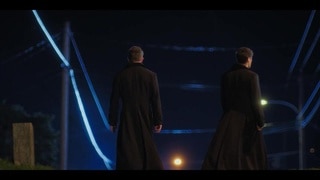Create a free profile to get unlimited access to exclusive videos, sweepstakes, and more!
Boeing Prepares for Its First Crewed Launch of Starliner Crew Capsule, Atop an Atlas Rocket
Boeing is vying to become the second commercial company to launch astronauts into space.
For decades, space exploration has been the exclusive privilege of government entities, but all of that is changing. Recently, private organizations have gotten in on the action with SpaceX ferrying astronauts to the International Space Station (ISS) and Intuitive Machines landing its Odysseus spacecraft on the Moon. NASA, for its part, is facilitating this transition through commercial crew and cargo initiatives in an attempt to foster the relatively new space economy.
If we ever want to explore the reaches of our own solar system or even travel to another star, like the courageous crew of SYFY's The Ark, it’s likely we’re going to need all the help we can get. If recent events are an indication, humanity’s spacefaring future will be achieved through the cooperation of many organizations, both private and public. Now, Boeing is hoping to add its name to the list of organizations who have carried astronauts into space. The first crewed test flight of Boeing’s Starliner crew capsule is slated for Monday, May 6.
For More on Space Exploration:
Radiation Could Limit Mars Missions to Four Years
Chimps in Space: Remembering Enos, the Chimpanzee Who Orbited the Earth
Why Sierra Space Popped Its Inflatable Space Station Module on Purpose
The First Astronauts to Fly a Mercury Rocket Since Project Mercury
Astronauts Suni Williams and Butch Wilmore arrived at Cape Canaveral on Thursday, April 25, a week and a half in advance of their scheduled departure from Earth. Their capsule will launch aboard an Atlas V rocket and spend a week at the International Space Station before returning home.
Atlas rockets were first developed in the 1950s with an intended use as intercontinental ballistic missiles (ICBMs), but they’re more well known for their spacefaring activities. The Atlas LV-3B, a derivation of the Atlas D, was used on several crewed missions throughout the ‘60s as part of NASA’s Project Mercury. Other rockets were used for all future crewed missions, but the Atlas family of rockets remained a popular choice for uncrewed missions.
The Atlas V is the longest-serving rocket in history, but it has never carried humans before. Originally designed by Lockheed Martin, the Atlas V is operated by the United Launch Alliance (ULA), a collaboration between Lockheed and Boeing. In 2021, ULA announced that the Atlas V would be retired once the remaining 29 rockets were used up. Even at the time, all of those rockets were already spoken for and one of them will carry Williams and Wilmore to the ISS.
Assuming everything goes off without a hitch, the launch on May 6 will be the first crewed launch of an Atlas rocket since Project Mercury and the first time that an Atlas V has ever carried humans into space. It will also be a long-awaited success for Boeing after years of challenges for the Starliner.
How to Watch Boeing's First Crewed Starliner Mission
Boeing has made two previous test flights, both of which were uncrewed, leading up this historic launch. The first attempt happened in 2019, when an uncrewed Starliner should have docked with the ISS for a weeklong shakedown cruise. Instead, a number of problems including a software glitch caused the engines to misfire and Starliner missed its shot. Boeing was able to safely recover the spacecraft and try again.
If they had made that flight successfully, Boeing would have been on target to start carrying astronauts the next year. Instead, the Starliner program was delayed and SpaceX jumped the line, carrying astronauts to the ISS in its Crew Dragon spacecraft in 2020. After a launch abort in 2021, Boeing finally completed its uncrewed test launch in 2022. Starliner spent five days docked at the ISS while astronauts tested its systems and unloaded supplies from its cargo hold. Now, it’s showtime.
Williams and Wilmore will launch from the Cape at approximately 10:34 p.m. ET on May 6, 2024. They’ll spend a little more than a day catching up to the ISS in orbit before docking to the station’s Harmony module in the early morning hours of Wednesday, May 8. They’ll spend a week at the station, testing the capsules systems and certifying the spacecraft for continued crewed missions. In the future, Starliner will carry up to seven astronauts at a time, the typical maximum crew aboard the ISS and each capsule can be flown up to ten times before reaching retirement.
NASA will begin broadcasting launch coverage at 6:30 p.m. ET on May 6 and continue coverage through the launch four hours later and orbital insertion. Afterward, NASA Television will provide continuous coverage until the capsule docks, the door opens, and the astronauts are safely aboard the station. It wasn’t long ago that the United States had zero domestic crew launch capability, soon we’ll have our choice of rides.
The Ark returns for Season 2 this summer, on Peacock!






















